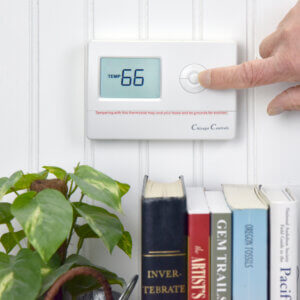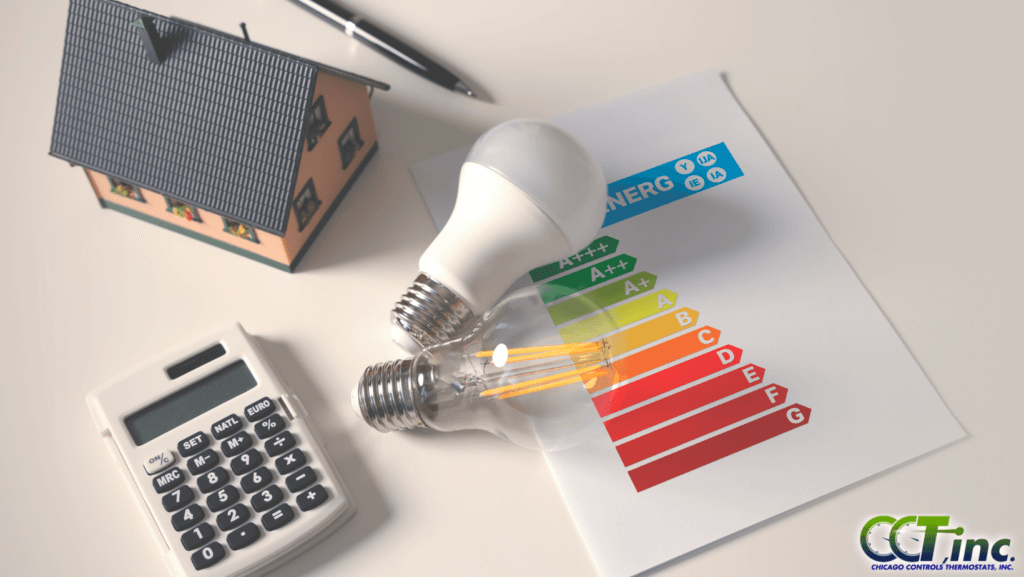
Adapting an authoritative yet solution-oriented approach to managing our properties is crucial in homeownership. One significant area that demands our attention is energy efficiency. It’s not just about saving money on utility bills—it’s also about playing our part in crafting a more sustainable future.
According to the U.S. Energy Information Administration, residential properties accounted for nearly 21% of the total energy consumption in the country in 2020. Of that, 52% goes to one use—heating and cooling. This statistic isn’t merely a number on paper—it’s a call to homeowners everywhere to take concrete steps toward energy conservation.
In response to this challenge, our team at Chicago Controls Thermostats curated an informative guide titled “Boost Your Bank Account, Save the Planet: 6 Easy Ways to Limit Energy Use.” This comprehensive eBook is a culmination of industry insights and practical strategies designed to help you transform your home into an energy-efficient powerhouse.
By leveraging our expertise in temperature control for property managers and homeowners, we’ve formulated a set of actionable steps that are both effective and easy to implement. Whether improving insulation, optimizing your heating and cooling systems, or exploring renewable energy sources, our guide covers a broad spectrum of energy-saving tactics.
So, without further ado, let’s delve into the heart of our guide. Read on and discover how you can make your home a model of energy efficiency.
1. Navigating the Energy Conundrum: Upgrading Outdated Appliances
ENERGY STAR appliances have emerged as the undisputed champions of sustainable living and energy efficiency. These powerhouses of performance and efficiency are not mere household appliances but pivotal players in the global effort to curb energy consumption and foster a greener future.
However, it’s crucial to understand that the ENERGY STAR label is not a static standard. Over time, the bar for energy efficiency has been raised, and newer models far surpass their older counterparts in energy conservation.
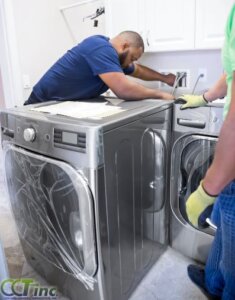
Choose ENERGY STAR for efficiency.
The call of the hour is to upgrade your essential appliances – refrigerators, dishwashers, and washing machines – to the latest ENERGY STAR-certified models. This simple yet strategic move can significantly lower your home’s energy usage, paving the way for a more sustainable future.
Let’s get into the specifics:
Energy Efficiency
ENERGY STAR appliances are not born—they’re made. Each model undergoes rigorous testing to earn this certification, guaranteeing optimal energy efficiency. These appliances offer the same level of performance as their non-certified counterparts but consume significantly less energy. For instance, upgrading an ENERGY STAR refrigerator can reduce up to 9% energy—and that’s excellent savings, given that this very necessary kitchen appliance can consume 7% of your total power usage!
Cost Savings
The benefits of ENERGY STAR appliances extend beyond environmental conservation. You can also reduce utility bills by reducing your home’s energy consumption. ENERGY STAR-certified dishwashers use approximately 12% less energy than conventional models, translating to an average savings of $35 per year.
Environmental Impact
ENERGY STAR appliances are silent warriors in the fight against climate change. By conserving energy, these appliances help reduce greenhouse gas emissions, save natural resources, and minimize your household’s environmental footprint.
Now, let’s explore some of the advanced features of ENERGY STAR-certified appliances and how they can help you save money:
- Refrigerators: Besides the 9% energy costs you’ll save with a new certified refrigerator, a stand-alone freezer only uses about 395 kWh of electricity, saving at least 10% over non-Energy Star models. Along with time and money-saving technology features, improved insulation helps maintain optimal temperature, reducing the workload on the compressor and saving energy. Innovative temperature management ensures efficient cooling, preventing unnecessary energy consumption.
- Dishwashers: ENERGY STAR dishwashers optimize energy and water usage, resulting in monetary savings. Features like soil sensors detect the level of dirtiness and adjust the cycle, accordingly, reducing the need for additional rinses. Efficient spray jets ensure thorough cleaning with minimal water usage. ENERGY STAR dishwashers help lower utility bills by using less energy and water.
-
A new dishwasher can save on energy and water use.
Washing Machines: Modern ENERGY STAR washing machines are designed with features that promote energy and water efficiency, translating to significant cost savings. High-efficiency motors consume less power while delivering powerful performance. These machines are optimized to use water efficiently, reducing water and energy consumption. Additionally, shorter wash cycles save time and further contribute to energy savings. Compared to non-certified models, ENERGY STAR washing machines can save up to 25% less energy and 33% less water, resulting in long-term financial benefits.
- Dryers: ENERGY STAR-certified dryers incorporate advanced features that boost efficiency and reduce energy consumption. They utilize sensor drying, automatically shutting off the machine when clothes are dry, preventing over-drying and energy waste. Additionally, some models offer a cool-down cycle that uses residual heat to finish drying your clothes, saving even more energy. Compared to conventional models, ENERGY STAR dryers use 20% less energy.
- Dehumidifiers: ENERGY STAR-certified dehumidifiers remove the same amount of moisture as standard units but use 15% less energy. They include features such as auto shut-off, which turns off the appliance when the water bucket is complete, and an energy-saving mode that lowers energy consumption when humidity is low. With these efficient features, you can maintain a comfortable humidity level in your home, save energy, and reduce utility costs.
- Water Heaters: ENERGY STAR-certified water heaters provide reliable hot water and use less energy. They are designed to heat water only when needed, eliminating standby energy losses. They can be 24%–34% more energy-efficient than conventional models, resulting in substantial cost savings over the unit’s lifespan. Energy-efficient models also reduce CO2 emissions, contributing to a healthier environment.
By choosing ENERGY STAR-certified appliances, you contribute to environmental conservation and enjoy the financial advantages of reduced energy and water consumption.
2. Caulk and Weatherstrip Windows and Doors

Reduce energy loss by sealing windows!
Drafty windows and doors can significantly impact the performance of your heating, ventilation, and air conditioning (HVAC) system. This increases energy consumption and higher utility bills while contributing to environmental concerns. However, by implementing simple measures like caulking and weatherstripping, you can effectively seal these areas and enhance your home’s energy efficiency and comfort.
Not only will this result in cost savings on your energy bills, but it will also help reduce your carbon footprint, positively impacting the environment. Therefore, it is crucial to recognize the importance of addressing drafty windows and doors as it is a small yet impactful step towards financial and environmental benefits.
3. Assess Insulation Levels
Insulation is a vital component in maintaining a comfortable and energy-efficient home. It acts as a protective barrier, preventing heat transfer between the inside and outside of a building. By understanding the different types of insulation and how they work, you can make informed decisions to improve your home’s insulation levels.
Here’s a breakdown:
Types of Insulation:
- Fiberglass Insulation: Made from glass fibers, it is one of the most common types used. It comes in rolls or batts and is effective at reducing heat transfer.
- Foam Insulation: Available as rigid or spray foam, it expands to fill gaps and provides excellent thermal resistance.
- Cellulose Insulation: Made from recycled paper or plant fibers, it is treated to be fire-resistant and offers good soundproofing qualities.
How Insulation Works
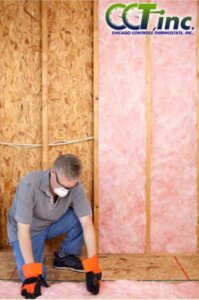
Benefits of Proper Insulation
- Energy Efficiency: Proper insulation minimizes heat loss in winter and heat gain in summer, reducing the workload on heating and cooling systems.
- Lower Utility Bills: Insulation helps save money on utility bills by reducing energy consumption.
- Improved Comfort: Consistent indoor temperatures and reduced drafts enhance overall comfort.
- Environmental Sustainability: Efficient insulation reduces greenhouse gas emissions by reducing energy usage.
By assessing your home’s insulation needs and considering the different types available, you can make informed choices to enhance comfort, reduce energy usage, and contribute to a more sustainable living environment.
4. Maintain Your HVAC System
Proper HVAC system maintenance is one of the most critical aspects of maintaining an energy-efficient home. Regular check-ups and cleaning your heating, ventilation, and air conditioning system can significantly improve efficiency, reducing energy consumption and lowering utility bills.
A well-maintained HVAC system performs at its peak, providing optimal comfort levels throughout the season while consuming minimal energy. Here’s an overview of the necessary maintenance tasks and their benefits:
Maintenance Tasks:
- Filter Replacement: One of the simplest yet most essential tasks is to replace the air filters regularly. Clogged filters restrict air flow, forcing the system to work harder and consume more energy.
- Seasonal Check-ups: Having a professional perform an annual or bi-annual check-up ensures that the system operates optimally. They can identify any issues early, preventing significant repairs down the line.
- Ductwork Inspection: Checking the ductwork for leaks and adequately sealing them can significantly impact the system’s efficiency. Leaks allow heated or cooled air to escape, wasting energy.
Benefits of HVAC Maintenance:
- Energy Efficiency: Routine maintenance ensures your HVAC system operates at peak efficiency, reducing energy consumption.
- Lower Utility Bills: You can expect lower utility bills with reduced energy consumption.
- Increased System Lifespan: Regular maintenance helps prolong the lifespan of your HVAC system, saving you the cost of premature replacement
- Environmental Sustainability: By consuming less energy, your HVAC system contributes less to greenhouse gas emissions, promoting a more sustainable environment.
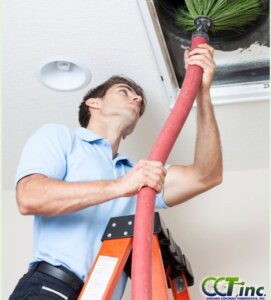
Pair your new HVAC system with a Landlord Thermostat and save even more!
5. The Imperative of Upgrading Your HVAC System
While simple maintenance measures like cleaning air filters are crucial, sometimes the most impactful step towards energy efficiency is a more substantial change. This brings us to the next important point – upgrading your HVAC system.
Understanding the Role of HVAC Systems
In our quest for energy conservation and sustainability, the role of Heating, Ventilation, and Air Conditioning (HVAC) systems cannot be overstated. Essential for comfort, these systems can also contribute significantly to a property’s overall energy consumption.
The Energy Consumption Challenge
According to the U.S. Department of Energy, HVAC systems account for up to 48% of total household energy usage in a typical home. The 2020 Residential Energy Consumption Survey reveals that 89% of U.S. households use air conditioning, underlining the critical importance of HVAC systems.
The Efficiency Gap in Older HVAC Systems
However, there’s a catch. Not all HVAC systems are created equal. Older models often lag in efficiency, increasing energy consumption and costs. This is where upgrading to a new, high-efficiency HVAC system becomes a viable option to save.
Unlocking Energy Efficiency with Newer Models
Newer HVAC systems use less power while delivering the same level of service. Thanks to advanced technologies like programmable thermostats and variable-speed motors, these systems offer precise climate control, reducing energy wastage. Industry data suggests that such an upgrade can cut energy consumption by up to 25%.
Improving Indoor Air Quality
Modern HVAC systems also significantly improve indoor air quality. Equipped with superior air filtration and humidity control features, they effectively reduce airborne pollutants, fostering a healthier environment.
Adding Value to Your Property
A new HVAC system isn’t just about comfort and efficiency— it can also enhance your property value. In today’s real estate market, energy efficiency is a sought-after trait, and a modern, efficient HVAC system can be a crucial selling point.

Enjoy a comfortable home and workspace with a new HVAC system.
The Return on Investment
While the initial cost of a new HVAC system may be substantial, the long-term benefits make it a wise investment. These include energy savings, improved comfort, potential increase in property value, and environmental benefits.
The Optimal Choice: ENERGY STAR Certified Models
Consider opting for an ENERGY STAR-certified model for maximum efficiency and environmental impact. It’s a choice that aligns with a future-focused, energy-conscious approach, delivering substantial benefits over the long term.
6. Invest in a Landlord Thermostat from Chicago Controls: A Smart, Cost-Saving Measure
As we round off our discussion on cost-saving measures, let’s spotlight a potent tool in the landlord’s arsenal – the Landlord Thermostat from Chicago Controls. These thermostats, explicitly designed for rental properties, offer an ingenious blend of energy savings, tenant comfort, and landlord control.
Chicago Controls’ Thermostats are not your average temperature controllers. They have advanced features that prioritize energy efficiency. What sets these thermostats apart is their tamper-proof design and automatic setback features. These characteristics make them a perfect fit for landlords looking to retain control over their property’s temperature settings while ensuring tenant satisfaction.
Maximizing Energy Efficiency with Tamper-Proof Design
The tamper-proof design of these thermostats ensures that tenants cannot alter the temperature settings. This feature protects landlords from excessive energy usage and higher utility bills. The automatic setback feature further enhances energy savings by resetting the thermostat to a pre-determined, energy-efficient temperature.
A Range of Models to Suit Your Needs
Recognizing the diverse needs of landlords and property managers, Chicago Controls offers a wide range of thermostat models, each with unique temperature limitations.
Choose Chicago Controls Thermostats and save!
HC7176 Residential Thermostat: This model limits the heat to 71 degrees and A/C to 76 degrees, striking a balance between tenant comfort and energy conservation.
- HC7372 Vacation Rental Thermostat: Specifically designed for vacation rentals, this thermostat limits the heat to 73 degrees and A/C to 72 degrees. This model can significantly reduce energy costs in rental properties, potentially saving landlords thousands of dollars annually.
- HC7272 Thermostat and HC7376 Thermostat for Elderly: With a slightly higher temperature limit, these models cater to specific tenant demographics like the elderly or very young who may require warmer temperatures.
- Warehouse Stat and HC7174SB Auto Setback Thermostat: These models are perfect for landlords seeking higher temperature limits or automatic setback features for heat control.
The Power of Smart Energy Choices
To create a sustainable future and save costs, you must prioritize making intelligent, energy-conscious decisions as a homeowner. Start by upgrading appliances, insulating your home, and performing HVAC maintenance. Consider using renewable energy sources.
Taking these proactive measures demonstrates your commitment to energy efficiency and financial responsibility. Choose a landlord thermostat from Chicago Controls as an additional cost-saving option.
Embrace these choices collectively to create a greener world for generations while enhancing your property’s value. Every energy-efficient option today invests in a brighter tomorrow for you and your family.
Combine the power of smart energy choices with a Landlord Thermostat today! Shop Chicago Controls models to save more!



